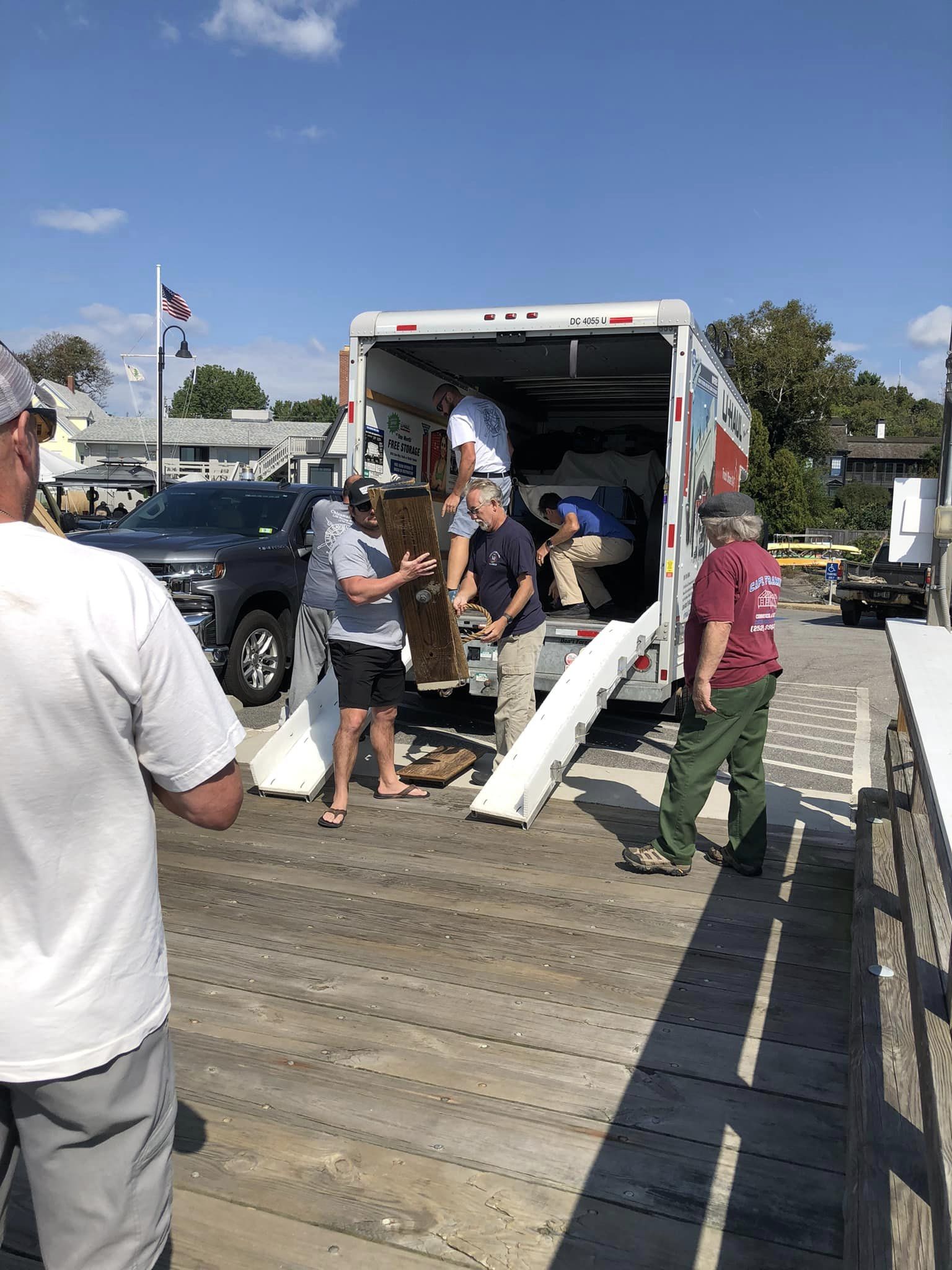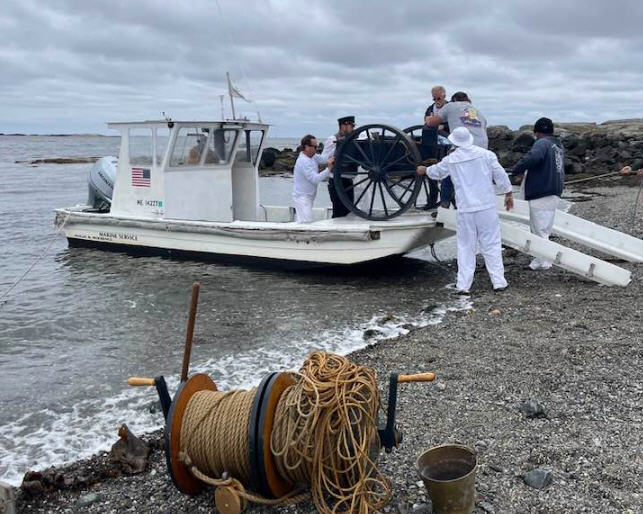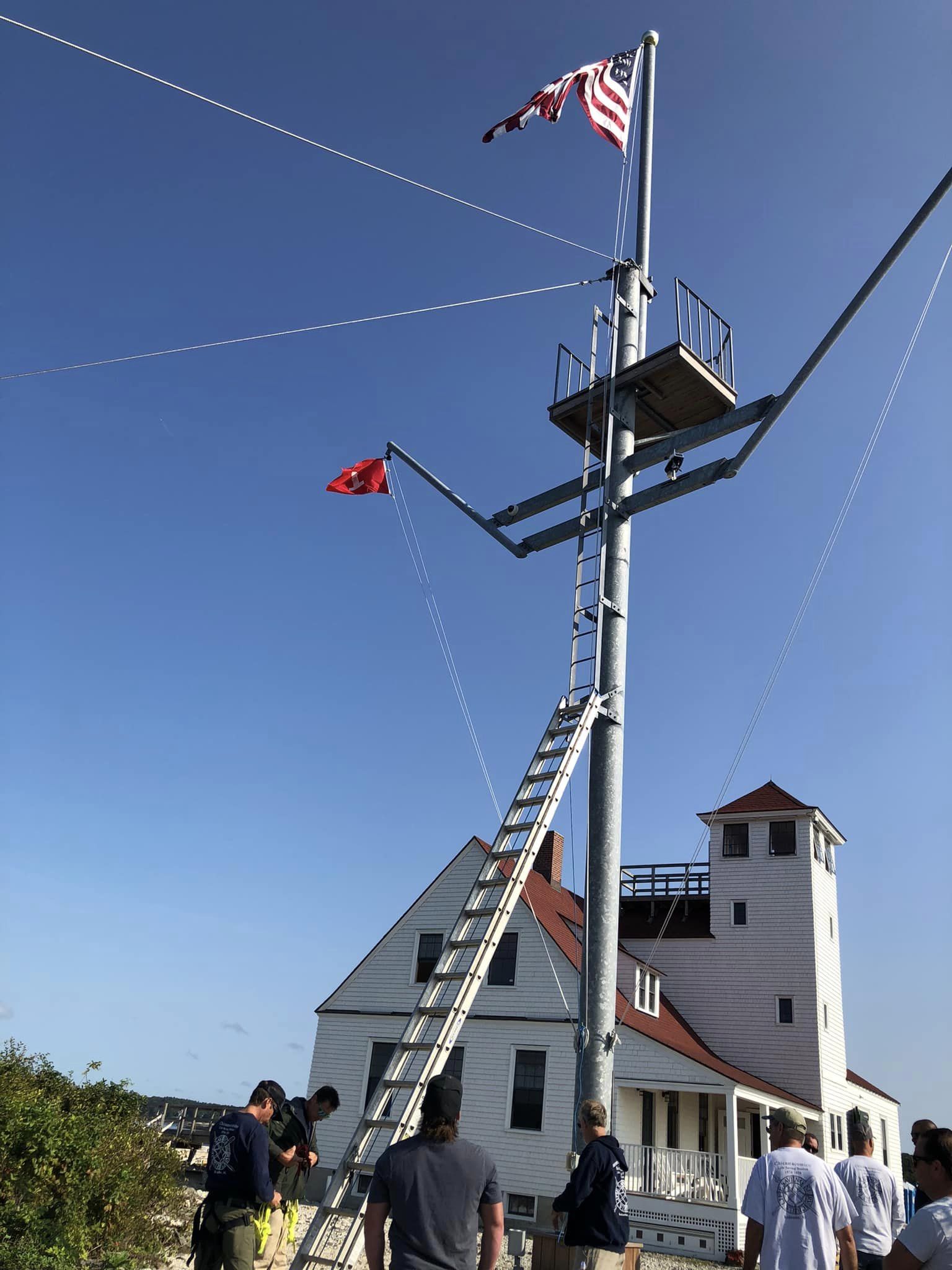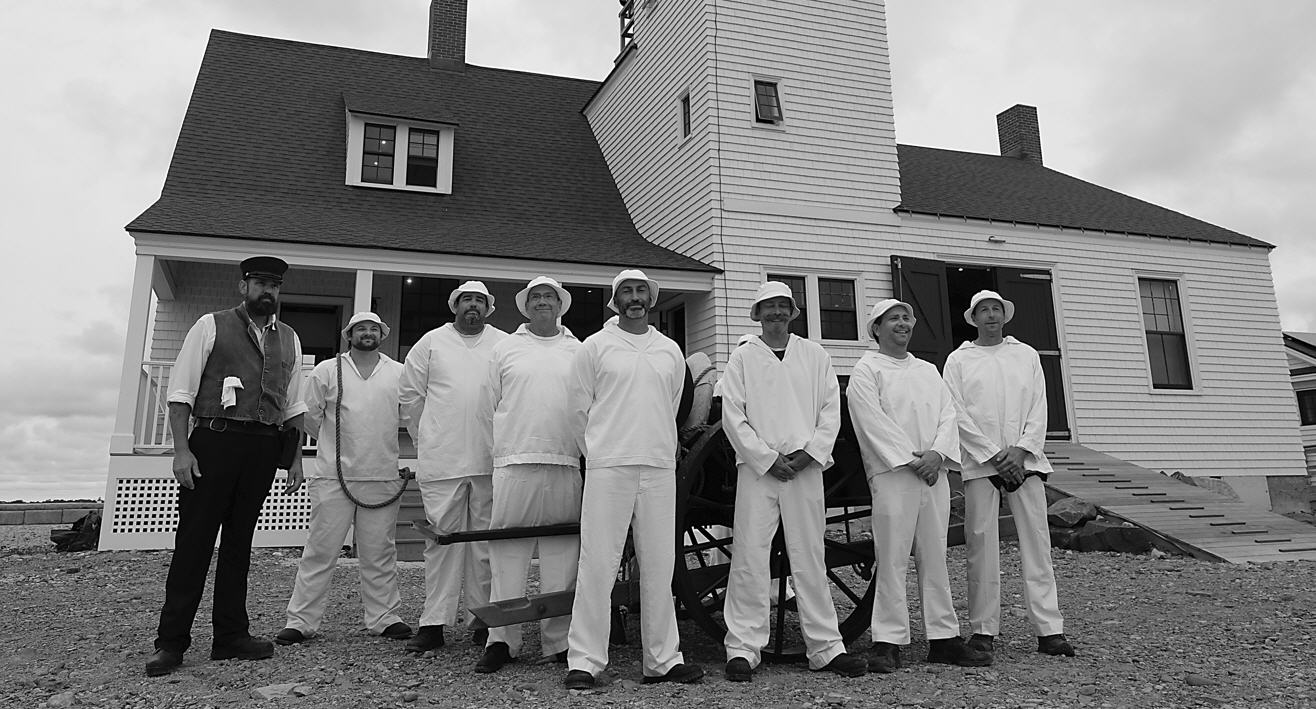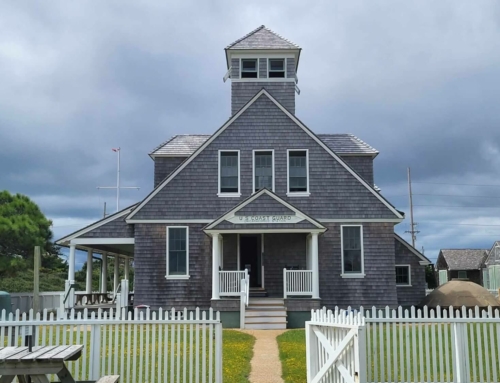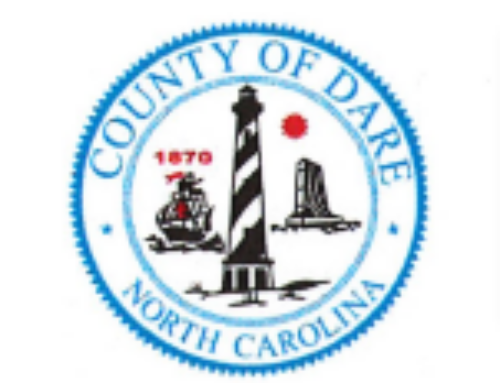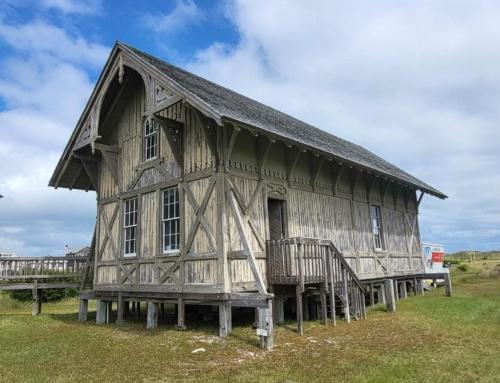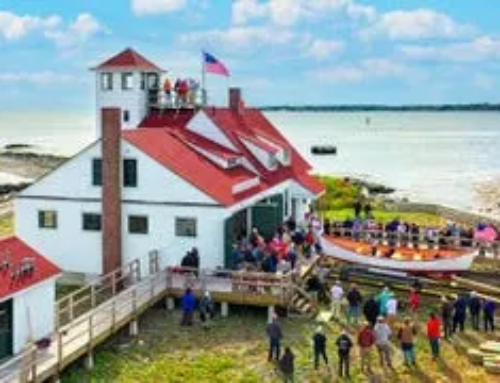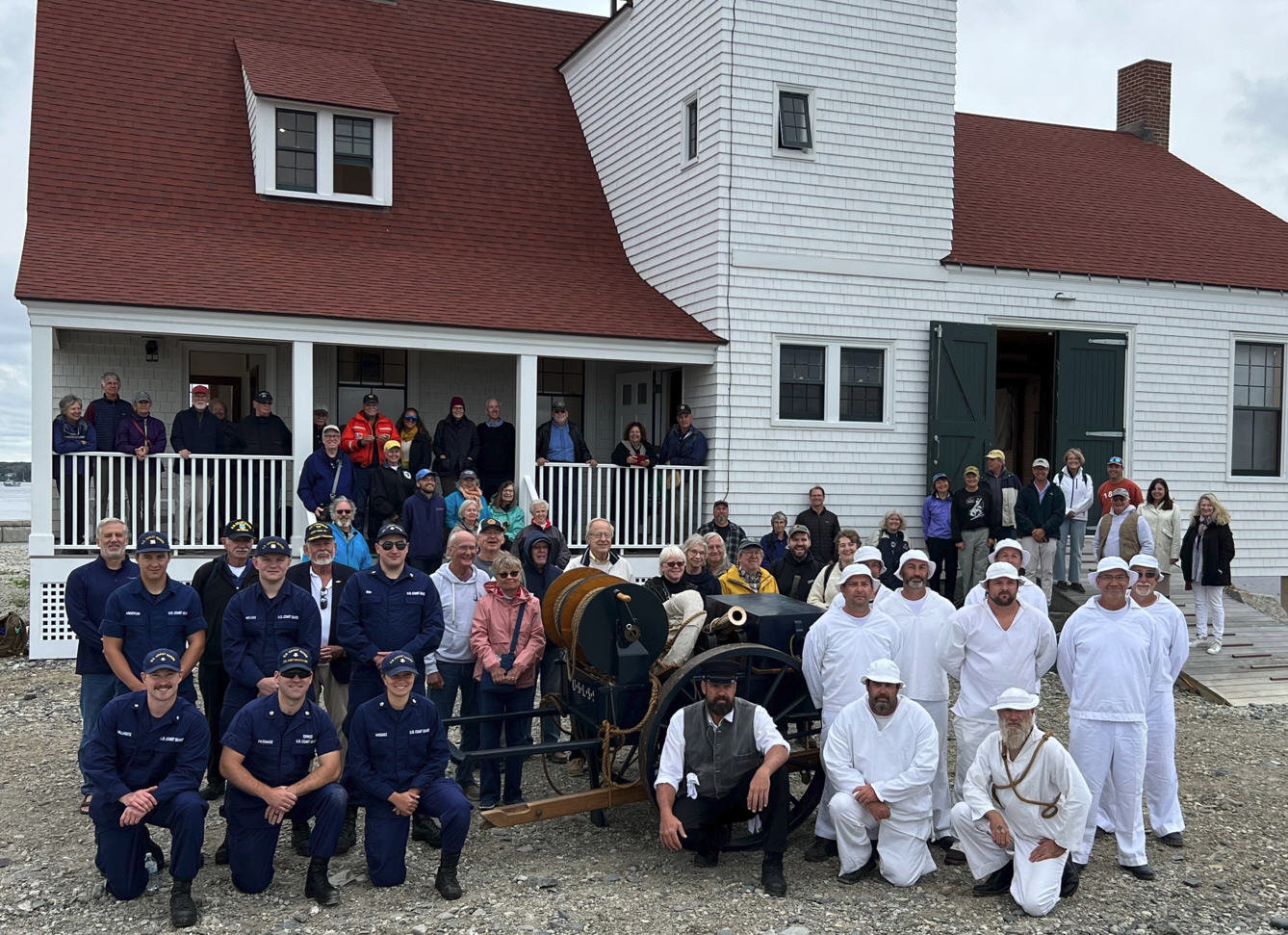
The Chicamacomico Team at the Wood Island Life-Saving Station in Maine. Photo from John Griffin. Volunteers are listed below.
A team of local volunteers who perform the weekly Beach Apparatus Drill reenactment at the Chicamacomico Life-Saving Station in Rodanthe gave a special performance 700 miles away from home at the annual U.S. Life-Saving Service Heritage Association (USLSSHA) Conference in Maine.
The September 23 event coincided with the official reopening of Maine’s Wood Island Life-Saving Station after an $18 million renovation project, and stemmed from an invitation from the USLSSHA for the Chicamacomico surfmen to take their show on the road.
“It’s rare that historic Life-Saving Stations do this sort of reenactment,” said Larry Grubbs, President of the Chicamacomico Board of Directors and longtime Drill Leader of the demonstration. “It may be done here and there on occasion, but I don’t believe there is any [site] that is doing it on a regular basis in the summertime like we are.”
“Because it was the Life-Saving Service Heritage Association Conference, most of the audience was connected with a [historic] station in the country,” said John Griffin, Chicamacomico Life-Saving Station Executive Director. “They knew the process of the drill, but had never seen one in real life.”
The Beach Apparatus Drill is a highlight of the historic Rodanthe site and museum, and it has been performed every Thursday during the summer months for decades.
During the heyday of the life-saving stations in the late 1800s and early 1900s, the crews at all Outer Banks stations had a weekly routine that was only interrupted when a rescue was required. This weekly schedule included regular and repetitive training on the steps required to perform a rescue in the ocean waters.
Considering that these rescues were usually in less than ideal conditions, (like during hurricanes, nor’easters, or times of warfare), the drills helped to ensure that tasks like setting up the breeches buoy and firing the line-throwing Lyle Gun were second nature for the surfmen.
During this roughly 10-minute procedure, each member of an eight-man team, led by the Drill Keeper, has a specific role to successfully launch a breeches buoy out into the ocean in order to pull ashore stranded victims. (A breeches buoy is a rescue apparatus that looks like a life preserver, but with built-in shorts.)
Decked out in canvas “summer uniforms,” the volunteer team pulls a half-ton wagon to the edge of the ocean, as close to the shipwrecked victims as possible. From here, a Lyle Gun is fired to set the pulley system that will eventually haul the people in peril to shore, while other members of the team set up the crotch poles and heavy rope lines that will keep the pulley system stable and operational.
It’s a flurry of movement, with ropes flying in every direction, surfmen climbing to the top of a 17-foot-tall wreck pole, and loud gunfire that startles any onlookers. The reenactment ends with one of the recused shipwreck victims, (usually a young volunteer from the audience), being placed in the breeches buoy before they are safely launched from the top of the wreck-pole platform to the ground.
The volunteers who perform the demonstration regularly at Chicamacomico have the routine down just as well as their original surfmen predecessors. But moving the reenactment from the sandy beaches of Rodanthe to a rocky little island close to Kittery, Maine was a challenge.
While the majority of the volunteers either drove or flew up the coast to the Wood Island Life-Saving Station, Larry Grubbs and Jamie Pauls hauled the beach cart, Lyle Gun, ropes, and all equipment up the East Coast in a U-Haul truck – a hefty load that was more than 1,000 pounds.
Once in Maine, an even more challenging chapter of the trek to Wood Island began, as the weighty equipment had to be transported .25 miles via a small boat, similar to a Carolina Skiff.
“The biggest challenge was getting the cart to the island,” said Grubbs. “We got the load down to about 800 pounds by separating the equipment, and they had a big wench that the lobstermen use to get their equipment on and off the boat, so we used that to lower the beach cart onto the boat and then take it to [the island].”
“The drill was on Saturday, and we spent Friday setting up all the equipment and making sure everything was safe and ready to go,” said Grubbs. “It’s a good thing that we had Friday to practice, because if we didn’t, it wouldn’t have [gone well].”
There were a number of differences between the weekly Rodanthe reenactment and the Wood Island Life-Saving Station reenactment due to the new location.
For one thing, the wreck pole platform was 30 feet in the air – not 17 feet – so the team decided to use one of their own to take the plunge instead of a volunteer. “Steve Williams volunteered to be rescued,” said Griffin. “We didn’t want a volunteer to have to be 30 feet in the air.”
“It was a much smaller area, and a much higher platform,” said Grubbs. “We changed the angle, changed the setup of equipment – we changed a lot in order to do it right.”
Regardless of the transportation and safety challenges, however, the Saturday afternoon drill in front of a crowd of Coast Guard personnel and life-saving station experts went perfectly.
“Aside from our people, there were maybe one or two people who had ever seen the drill before, and there were life-saving station representatives from all over,” said Griffin. “Maine, Cape Cod, Delaware – it was a [knowledgeable] crowd.”
The entire trek to and from Maine took around six days, which included four days of travel for the folks who drove up and down the Eastern Seaboard.
But based on the warm reception – and the opportunity to shine a spotlight on Chicamacomico in a crowd of famous life-saving stations – the local volunteers attest that it was all worth it.
“It was a long ride, and a lot of work, but it was definitely worth the trip,” said Jamie Pauls.
“It was certainly a whole lot of preparation for a 10-minute demonstration,” said Griffin. “But the [Lyle Gun] shot was successful, the rescue was successful, and the entire demonstration as successful… Everyone was blown away, so it was worth the work.”
The Chicamacomico Life-Saving Station volunteers who attended the Maine event are as follows:
- Larry Grubbs
- Jen Carlson
- Carl Smith
- John Griffin
- Surfmen
- Jamey Pauls
- Mike Daugherty
- Jason Walsh
- Andrew Dickerson
- Steve Williams
- Rob Wernock
- Rob Huggett
- Brett Ryan
- Ryan Gentry

